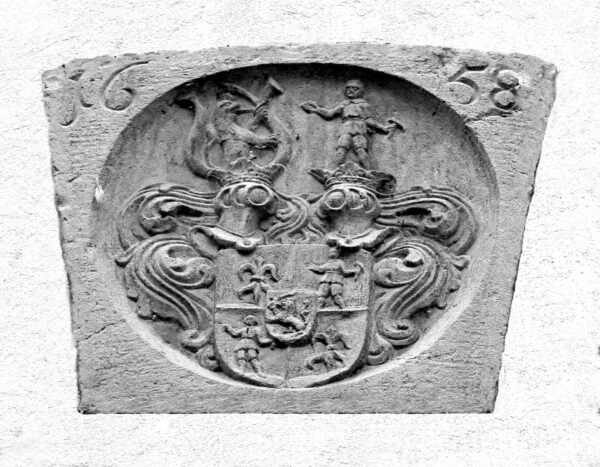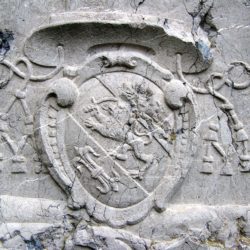
Coat of arms of the Witzenstein family in Ljubljana
LJUBLJANA, KRIžEVNIšKA ULICA 7
Location of the coat of arms: portal
Built into the façade above the entrance to the house on Križevniška ulica 7 is a stone coat of arms with the year 1658 carved above it. The coat of arms belonged to the Witzensteins, who owned the house in the seventeenth century. The first member of the family to be ennobled was the town judge and mayor Marcus Witz in 1630. One of his sons, Karl, was appointed mining judge for Carniola and Gorizia in 1635. According to Johann Weikhard Valvasor, he turned over his office to Baron Rosetti in 1654, after he fell ill and lost all hope of recovery (although he continued to live for almost twenty years). As a mining judge, he officiated in his house on (modern) Križevniška ulica 7 (formerly 9), which was placed under imperial protection—the so-called salva guardia—in 1646. On that same occasion, the emperor expanded his family name Witz with the predicate Witzenstein and improved his coat of arms. The old Witz coat of arms with a lion and lilies was added a mining gnome holding a mandrill, symbolizing Karl’s association with mining industry. Later, he had his new coat of arms carved above the entrance to his house on Križevniška ulica (probably following its renovation), where it can still be seen.
After he made himself a fortune through two marriages and purchased several landed estates—Hotič (Höttisch) on the Sava River, the Lebek seigniory (Liebegg) with the market town of Vače (Waatsch), Ponoviče Mansion (Ponowitsch) near Litija as well as Boltija (Waldhof) and Gabrje (Gallenhof) near Gabrovka—Karl was elevated to baronial rank in 1667. His predicate was expanded with the names of his estates in the Central Sava Valley and his coat of arms underwent minor changes.
The Witzenstein family became extinct in the male line in the late seventeenth century or early eighteenth century.

